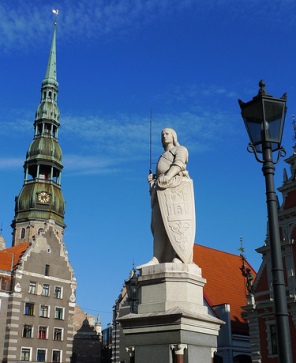

Old Town Rātslaukums, Town Hall Square
Statue of Saint Roland, patron saint of Riga, stands near House of Blackheads and city Town Hall. It was erected in 1897. However current figure is a copy. The original is kept at the Saint Peter's Cathedral. In the Middle Ages, Statues of Saint Roland were erected as a sign of bourgeois freedom and an expression of the economic prosperity of the city. In addition to the statues expressly designated as Roland, similarly designed knight figures emerged as a symbol of the civil liberties defended or at least claimed by the citizens. It was the identity of a city with its own jurisdiction. The glory was based on the Hruotland fate, which was under Charles the Great in Counties in Breton. Roland fell into the battle against the Basques under Count Lupus in the Pyrenees in the valley of Roncesvalles on August 15, 778.
History and features
Sculpture of Roland, made of stone or wood,
was found in the Middle Ages mainly in the cities of Northern Germany,
which had concluded agreements of mutual trade and economic cooperation
and gradually formed the Hanseatic League. Riga joined this union at the
end of the 13th century as an important and influential trading outpost
of the Livonian Confederation, but it is difficult to say how many
wooden sculptures of Roland were in the city's commercial district
during the medieval period. It is only known that in 1474 the Riga City
Council commissioned the woodcarver Jēkabs to create a new statue in the
place of the previous one, as evidenced by the records of the city
chronicle. It is the first surviving documentary mention of the statue
of Roland in Riga. The Rolands in Riga and other Hanseatic cities often
came to the tree with a request for help, holy protection, with prayers
for health, profit and successful trade, as well as with the hope of
finding a fair trial.
Versions of the origin
The exact origin
and meaning of the statue of Roland is unknown, but there are several
versions about the formation of the image of Roland in the cultural
space of the European Middle Ages. Some researchers associate this
statue with the personality of the legendary knight Roland, the nephew
of Emperor Charlemagne. The statues of Roland that adorned the
commercial districts of medieval Hanseatic cities are said to have
symbolized the free market, the independence of the city council, which
held supreme judicial and commercial rights, and the priority of secular
institutions over religious institutions.
Roland's sword was an
allegory of justice and indicated the inevitability of revenge.
Installation of a stone statue of Roland
Roland's statue was
installed in Town Hall Square as a symbolic decoration of the artesian
well. It was the geometric center of Riga; The tip of Roland's sword
traditionally marked the point of intersection of the coordinates. The
new statue replaced the previous one, made of wood, which had already
deteriorated by then. Apparently, the installation of Roland's new
statue between the Riga City Hall and the House of the Black Men at the
end of the 19th century was intended to emphasize the conditional
historical dominance of German culture in the Baltic Sea region with a
special "confrontation of monuments".
Partial destruction and
restoration
During the Battle of Riga in 1941, the sculpture was
damaged by artillery fire. In 1970, its partial restoration was carried
out by the Estonian sculptor Marija Ehelaide, who also participated in
the restoration of the sculptural ensemble of the portals of St. Peter's
Church. Later, in 1984, the sculpture was given to the Riga Architecture
and Urban Planning Promotion Center, which was located in the restored
Peter's Church, where the sculpture is still located today.
Making a copy
In May 1999, a copy of the sculpture of Roland by
Edvīnas Krūmins was installed on a specially made pedestal. Thus, there
are two statues of Roland in Riga (the original is in St. Peter's
Church, the copy is in the center of Rātslaukumas). It should be noted
that Riga's Roland statue is the most northerly in Europe (the
southernmost Roland statue in Europe is in Dubrovnik, Croatia). This
copy is an artistic monument of local importance.